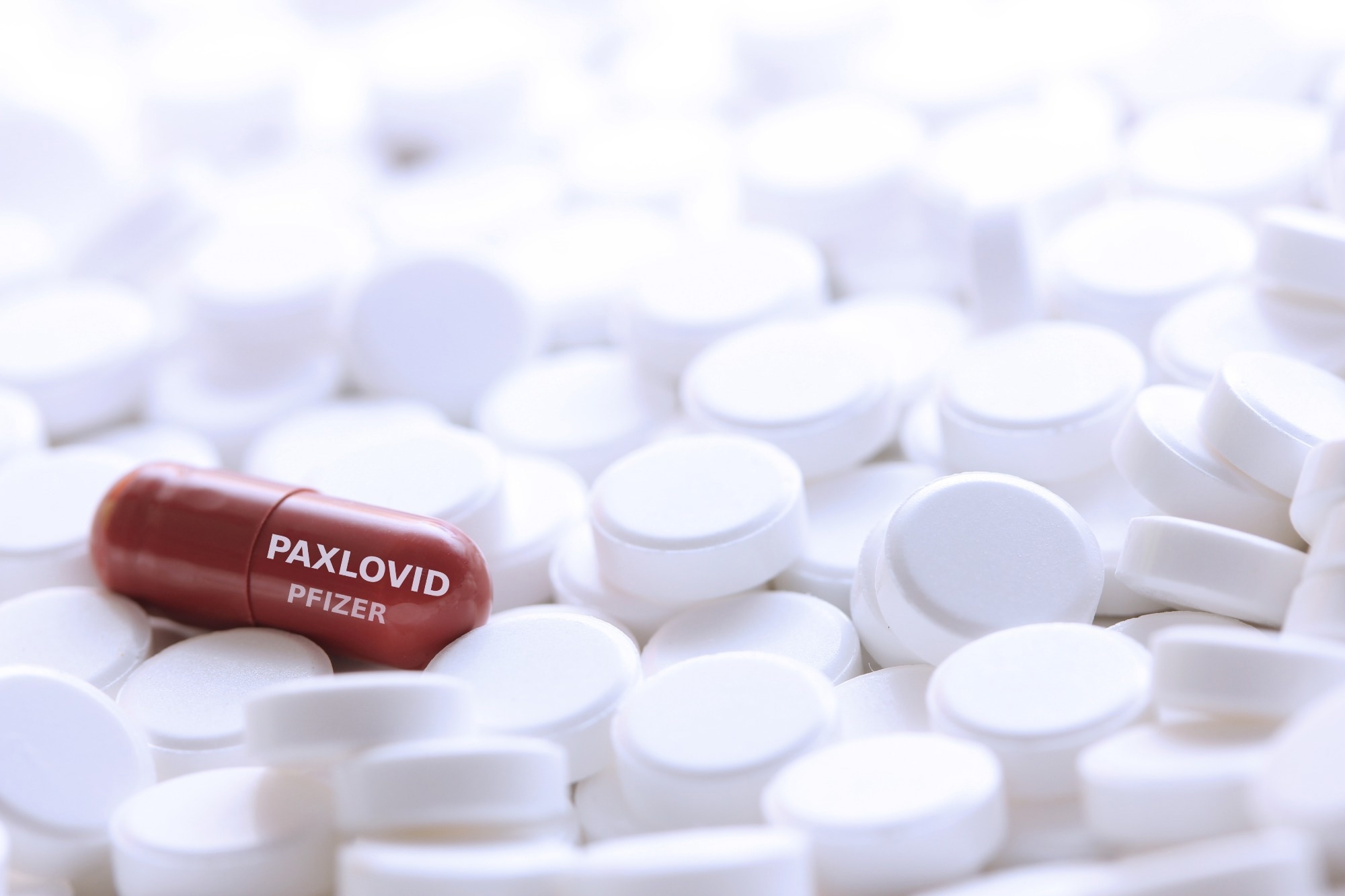In a recent review published in the Pharmaceutics, a group of authors explored the design, synthesis, and mechanism of action of Paxlovid, a Protease inhibitor (PI) drug combination for treating coronavirus disease 2019 (COVID-19).
 Study: The Design, Synthesis and Mechanism of Action of Paxlovid, a Protease Inhibitor Drug Combination for the Treatment of COVID-19. Image Credit: Tobias Arhelger/Shutterstock.com
Study: The Design, Synthesis and Mechanism of Action of Paxlovid, a Protease Inhibitor Drug Combination for the Treatment of COVID-19. Image Credit: Tobias Arhelger/Shutterstock.com
Background
The COVID-19 pandemic, caused by the severe acute respiratory syndrome coronavirus 2 (SARS-CoV-2) virus, significantly challenged global healthcare systems and medical science.
In response, researchers worldwide developed vaccines with innovative mechanisms and small-molecule antivirals targeting crucial viral proteins.
Among these, PaxlovidTM, a blend of nirmatrelvir and ritonavir PIs, stands out for its effectiveness in treating COVID-19.
Nirmatrelvir inhibits SARS-CoV-2's main protease, vital for viral replication, while ritonavir boosts nirmatrelvir's effectiveness by inhibiting Cytochrome P450 3A4 (CYP3A4), an enzyme that would otherwise degrade nirmatrelvir quickly.
Further research is needed to develop alternative main protease (MPro) inhibitors despite the success of the nirmatrelvir-ritonavir combination, ensuring continued effectiveness against COVID-19.
PIs as antivirals for Hepatitis C virus (HCV) and Human immunodeficiency virus (HIV)
PI Drugs for HCV and HIV Infections
PIs are key in treating HCV and HIV infections. HCV, a small ribonucleic acid (RNA) virus causing hepatic diseases, is targeted by PIs like asunaporevir, telaprevir, and boceprevir, focusing on the nonstructural (NS)3/4A serine protease.
These inhibitors are peptidomimetics, containing peptide bonds and a 'warhead' group that binds covalently but reversibly to the enzyme's active site.
HIV PIs target the virus's aspartic acid protease, which is crucial for viral replication. They are used in antiretroviral therapy, transforming HIV from fatal to chronic.
Development and mechanism of Nirmatrelvir
Nirmatrelvir, developed from Pfizer's earlier SARS-CoV-1 PI .. PF-00835231, faced challenges in oral absorption.
Modifications like altering the warhead and substituting various molecular components enhanced its binding affinity and antiviral activity, eventually leading to nirmatrelvir with a nitrile warhead, improving solubility and synthesis.
Despite different warheads, its structural similarity to boceprevir, and its role as a covalent inhibitor of SARS-CoV-2 Mpro makes it significant in COVID-19 treatment.
Synthesis of nirmatrelvir
Nirmatrelvir’s synthesis involves coupling the P1 building block and the P2-P3 dipeptide, with the final step being the formation of the nitrile warhead.
The process starts with protected amino acid derivatives, proceeding through stages like Boc-deprotection, ester cleavage, and dipeptide formation.
The synthesis yields nirmatrelvir with high efficiency and introduces a new approach involving a Ugi-type three-component reaction for higher diastereoselectivity.
Synthesis and structure-activity relationship (SAR) study of nirmatrelvir analogs
Research by Chia and co-workers led to the synthesizing nirmatrelvir analogs with different P1′ moieties, examining the role of the warhead in antiviral activity.
These studies revealed varying levels of effectiveness in protease inhibition and antiviral activity, with some derivatives showing similar or superior effects to nirmatrelvir. However, challenges in cell penetration and specificity to SARS-CoV-2 limited the broader application of these analogs.
Novel covalent and non-covalent inhibitors of SARS-CoV-2 Mpro
Recent developments in SARS-CoV-2 Mpro inhibitors have introduced both peptidomimetic and non-peptidic inhibitors.
These include warheads, such as epoxide rings and fluoromethyl groups, offering alternative mechanisms of covalent binding to the enzyme.
Non-covalent inhibitors, like ensitrelvir, show lower reactivity but better selectivity due to their secondary interaction nature. These developments represent crucial steps in diversifying therapeutic options against COVID-19 and its evolving strains.
Ritonavir as a pharmacokinetic enhancer
Structure, activity, and interactions of ritonavir
Originally an HIV protease inhibitor, Ritonavir is known for its efficacy at low doses (~100 mg) in inhibiting the CYP3A4 enzyme, a crucial element in drug metabolism.
While high doses of Ritonavir are poorly tolerated, its low-dose effectiveness is leveraged in combination therapies with other HIV protease inhibitors, enhancing their half-lives and thus reducing required dosages.
This unique use of Ritonavir has been explored even in early COVID-19 treatments. However, its use poses risks of significant drug–drug interactions, especially with medications metabolized by CYP3A4, potentially elevating their levels to toxic concentrations.
Additionally, Ritonavir's effect on other enzymes and transport proteins is noted, albeit of lesser importance in Paxlovid treatment.
Synthesis of ritonavir
developed at Abbott Laboratories, Ritonavir's synthesis involves complex chemical processes, combining chiral amine and carboxylic acid building blocks.
The synthesis starts with a cyclocondensation reaction involving thioformamide and ethyl 2-chloroacetate, followed by a series of steps leading to the formation of ritonavir.
This intricate process involves various intermediate compounds and chemical reactions, including triethylamine and 4-dimethylaminopyridine, highlighting the sophistication required in pharmaceutical synthesis.
The production of Ritonavir demonstrates the intricate chemical engineering necessary to develop effective pharmaceutical agents.
Paxlovid—application and activity against mutant variants
Paxlovid, combining nirmatrelvir and ritonavir, has shown significant efficacy in reducing COVID-19-related hospitalizations and mortality.
While it has gained emergency use authorization in various regions, its effectiveness against emerging strains and mutant variants is under continuous scrutiny.
The evolving landscape of SARS-CoV-2 mutations necessitates ongoing monitoring to ensure the sustained efficacy of treatments like Paxlovid.